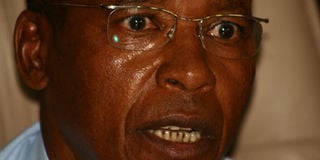Report reveals what killed Mutula Kilonzo

Former Makueni Senator Mutula Kilonzo. FILE PHOTO | NATION MEDIA GROUP
What you need to know:
Dr Mwangi explained to the trial magistrate how he found the body in the bedroom.
He said he examined the body four hours after he was reported dead.
There was foaming from the mouth and blood flowing from both the nose and mouth to the right side of the head, he told the court.
Former Makueni Senator Mutula Kilonzo died of massive bleeding caused by high blood pressure, a government report released on Wednesday, four years after his death, revealed.
The report was presented during a hearing in the inquest into Mr Kilonzo's death at the Machakos Law Courts by Dr S W Mwangi, a general medical practitioner based in Nakuru.
“Mr Kilonzo died of massive haemorrhage into the chest and cranial cavity due to significantly elevated blood pressure due to several factors including but not limited to excessive ingestion of pseudoephedrine (nasal/sinus decongestant) in combination with caffeine,” said the report.
TESTIMONY
In his testimony, Dr Mwangi said it was reported that Mr Kilonzo failed to wake up from his sleep.
He told the inquest that the former lawmaker’s son, Senator Mutula Kilonzo Jr, and a farm worker, Mulei Mulwa, said he had not complained of any illness on April 16, 2013.
Dr Mwangi explained to the trial magistrate how he found the body in the bedroom.
He said he examined the body four hours after he was reported dead.
WAS FOAMING
There was foaming from the mouth and blood was flowing from both the nose and mouth to the right side of the head, he told the court.
Dr Mwangi also noticed the senator, who was also a lawyer, had vomited.
The hearings resume on September 26.
“Dr Mwangi is not a pathologist but a general practitioner, although he was in the team of pathologists who conducted the autopsy of the late senior lawyer,” a family member who spoke to the Nation said after releasing the report collected from court by lawyer Miriam Kerubo Onsogo.
POST-MORTEM REPORT
Speaking on Wednesday evening, a family member said “the government has never provided us with a copy of the post-mortem report.
'It was generally felt that the massive bleeding could not be explained.”
“The report should have been given to the family first before being produced in court,” said the family member.
The family member also said a UK pathologist hired by the family, Prof Ian Calder, could not conclusively make a finding as to what caused the heavy bleeding, due “to interference with the samples between Nairobi and UK”.
SAMPLES TAKEN
The samples were taken from the body at Lee Funeral Home and were being handled by senior police officers and government doctors.
“The government should come clean and hold somebody responsible for the interference, since he could not have been allowed to travel with the samples. They had to be delivered with the full knowledge of the government agencies,” he added.
He said even if there was interference, they should have gotten fresh samples instead of “keeping quiet yet it was the government’s responsibility to determine the cause of death”.
TANGIBLE RESULTS
The family member said the government owed them and Kenyans an explanation because they were eager to know what toxin caused the haemorrhage.
After Mr Kilonzo's body was moved to Lee Funeral Home, an autopsy was carried out by a team of senior government pathologists led by Dr Andrew Gachie, Dr Johansen Oduor, Prof Calder, Dr Emily Rogena, Dr Luke Musau, Dr Mwangi and senior police officers.
“The inquest has gone cold. Its timing raises serious questions,” the family member stated, adding, “It will be closed with no tangible results.”




